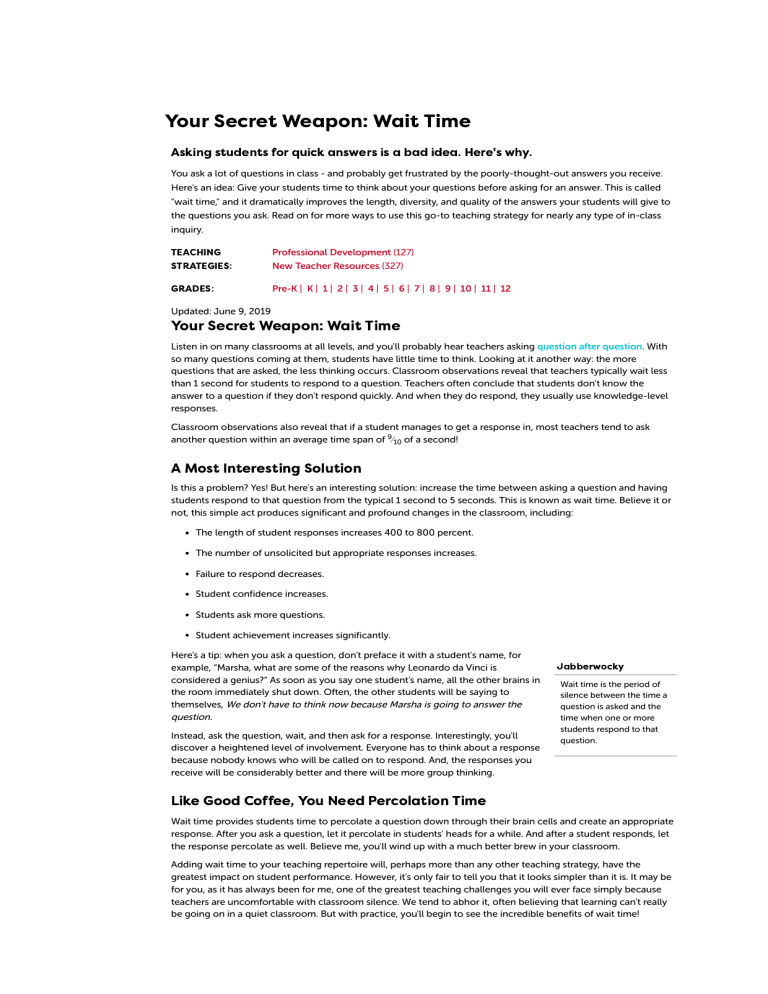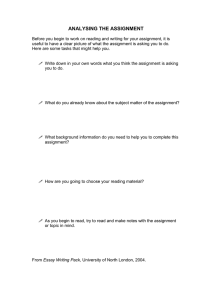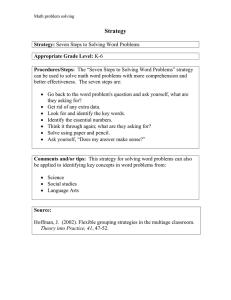
Your Secret Weapon: Wait Time Asking students for quick answers is a bad idea. Here's why. You ask a lot of questions in class - and probably get frustrated by the poorly-thought-out answers you receive. Here's an idea: Give your students time to think about your questions before asking for an answer. This is called "wait time," and it dramatically improves the length, diversity, and quality of the answers your students will give to the questions you ask. Read on for more ways to use this go-to teaching strategy for nearly any type of in-class inquiry. TEACHING STRATEGIES: Professional Development (127) GRADES: Pre-K | K | 1 | 2 | 3 | 4 | 5 | 6 | 7 | 8 | 9 | 10 | 11 | 12 New Teacher Resources (327) Updated: June 9, 2019 Your Secret Weapon: Wait Time Listen in on many classrooms at all levels, and you'll probably hear teachers asking question after question. With so many questions coming at them, students have little time to think. Looking at it another way: the more questions that are asked, the less thinking occurs. Classroom observations reveal that teachers typically wait less than 1 second for students to respond to a question. Teachers often conclude that students don't know the answer to a question if they don't respond quickly. And when they do respond, they usually use knowledge-level responses. Classroom observations also reveal that if a student manages to get a response in, most teachers tend to ask another question within an average time span of 9⁄10 of a second! A Most Interesting Solution Is this a problem? Yes! But here's an interesting solution: increase the time between asking a question and having students respond to that question from the typical 1 second to 5 seconds. This is known as wait time. Believe it or not, this simple act produces significant and profound changes in the classroom, including: The length of student responses increases 400 to 800 percent. The number of unsolicited but appropriate responses increases. Failure to respond decreases. Student confidence increases. Students ask more questions. Student achievement increases significantly. Here's a tip: when you ask a question, don't preface it with a student's name, for example, “Marsha, what are some of the reasons why Leonardo da Vinci is considered a genius?” As soon as you say one student's name, all the other brains in the room immediately shut down. Often, the other students will be saying to themselves, We don't have to think now because Marsha is going to answer the question. Instead, ask the question, wait, and then ask for a response. Interestingly, you'll discover a heightened level of involvement. Everyone has to think about a response because nobody knows who will be called on to respond. And, the responses you receive will be considerably better and there will be more group thinking. Jabberwocky Wait time is the period of silence between the time a question is asked and the time when one or more students respond to that question. Like Good Coffee, You Need Percolation Time Wait time provides students time to percolate a question down through their brain cells and create an appropriate response. After you ask a question, let it percolate in students' heads for a while. And after a student responds, let the response percolate as well. Believe me, you'll wind up with a much better brew in your classroom. Adding wait time to your teaching repertoire will, perhaps more than any other teaching strategy, have the greatest impact on student performance. However, it's only fair to tell you that it looks simpler than it is. It may be for you, as it has always been for me, one of the greatest teaching challenges you will ever face simply because teachers are uncomfortable with classroom silence. We tend to abhor it, often believing that learning can't really be going on in a quiet classroom. But with practice, you'll begin to see the incredible benefits of wait time! Excerpted from The Complete Idiot's Guide to Success as a Teacher Anthony D. Fredericks, Ed.D. Excerpted from The Complete Idiot's Guide to Success as a Teacher © 2005 by Anthony D. Fredericks. All rights reserved including the right of reproduction in whole or in part in any form. Used by arrangement with Alpha Books, a member of Penguin Group (USA) Inc. To order this book visit Amazon's web site or call 1-800-253-6476. Buy This Book Search our growing library of professionally created teacher resources. Enter your search here… Search With the help of certified and current classroom teachers, TeacherVision creates and vets classroom resources that are accurate, timely, and reflect what teachers need to best support their students. About TeacherVision FAQs Contact Us Teacher Advisory Board Terms of Use Advertise with Us Premium Pricing Privacy Policy Affiliate Links Newsletters Cancellation Policy Site Map TeacherVision is part of the FEN Learning family of educational and reference sites for parents, teachers and students. FEN Learning is part of Sandbox Networks, a millennial learning company, reaching hundreds of millions of people across the globe.


